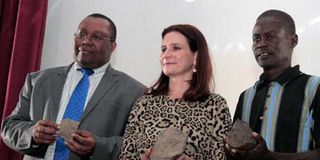World’s oldest stone tool discovery unveiled in Nairobi

National Museums of Kenya Director General Dr Mzalendo Kibunja, Stony Brook University research associate professor Dr Sonia Harmand and Sammy Lokorodi of Nariokotome village in Turkana County, who helped find the oldest tools in the world, during a press conference May 22, 2015 at the National Museums of Kenya. The 3.3million year-old tools were discovered in Lomekwi 3, West Turkana, by a Franco-Kenyan research team. PHOTO | DIANA NGILA | NATION
What you need to know:
- The tools, which are 3.3 million years old, were found at a site called Lomekwi 3, which is on the northern shores of Lake Turkana
- The next oldest tools were found at Gona, Ethiopia, and have been dated at 2.6 million years old.
- The discovery, which has been reported in the latest issue of the journal Nature, also challenges the savannah hypothesis which argues that early man lived in the savannah by the time he began making tools.
The discovery of the oldest stone tools in the world and the role a man from Turkana County played in finding them was announced Friday at the National Museums of Kenya in Nairobi.
The tools, which are 3.3 million years old, were found at a site called Lomekwi 3, which is on the northern shores of Lake Turkana in Turkana County.
They now surpass the next oldest tools which were found at Gona, Ethiopia, and have been dated at 2.6 million years old.
Dr Sonia Harmand, who is the leader of the West Turkana Archaeological Project that is undertaking the research, told the gathering that the Lomekwi 3 discovery had changed the archaeological record.
“Our finding finally disproves the long-standing assumption that Homo habilis was the first tool-maker,” she said in a statement. Because Homo habilis lived 700,000 years after the stone tools were made, the latest discovery points to another earlier ancestor who could make tools.
“The cores and flakes are clearly knapped and not the result of accidental fracture”, said Dr Harmand. Knapping is the deliberate removal of unwanted pieces of rocks or flakes from a bigger rock in order to make a tool from it.
Before the use of knapping, rocks would have been hit together in the hope that a usable tool would result.
The discovery very nearly didn’t happen, and a man from Turkana, Sammy Lokorodi, played an important role in it.
On the morning of July 9, 2011, the research team had gotten lost after following the wrong dry riverbed on the way to a site. They spotted an area that looked promising while looking for the correct path.
“Something was really unique about this place. We could tell that this zone had a lot of hidden areas just waiting for us to be explored,” Dr Harmand said, before being interrupted by applause for Mr Lokorodi, who had spotted the tools. “So this wrong turn and Sammy’s sharp eyes led us to what we had come searching for,” she said.
Dr Harmand further revealed that further surveying of the site in 2012 had revealed 19 well-preserved artefacts in the sediment, or in situ, and 130 more tools on the surface around the area.

A stone tool discovered near Lake Turkana, Kenya is pictured in this undated handout photo provided by MPK-WTAP. Scientists unveiled the discovery of the world's oldest tools in Nairobi on May 22, 2015. At 3.3million years old, they are 700,000 years older than any other such stone tools ever found and predate by 500,000 years the earliest-known fossils of the genus Homo, meaning they likely were fashioned by a more primitive species on the human family tree. PHOTO | REUTERS
Mr Lokorodi told the Daily Nation that he enjoyed surveying.
“The team were surveying when I saw the stone tools. I called Johnson and Johnson called Sonia. Sonia said ‘it’s the one we are looking for,’” he said. He was accompanied at the event by his colleagues Fred Wambua, Ali Mwanzia, Charles Awote, and Peter Leeyu.
The discovery, which has been reported in the latest issue of the journal Nature, also challenges the savannah hypothesis which argues that early man lived in the savannah by the time he began making tools.
Dr Jason Lewis described tests that show the Lomekwi area was woodland when the tools were made, not open savannah.
Another member of the research team, Dr Prat Sandrine noted that while the identity of the toolmaker was not clear, there were two possibilities that could be investigated. The first is Kenyanthropus platyops, which interestingly was discovered only one kilometre from where the stone tools were found, while the other was Australopithecus afarensis.
“We were not surprised to find to find stone tools older than 2.6 million years because palaeontologists have been saying for the last decade that, they should be there somewhere,” said Dr Harmand.





